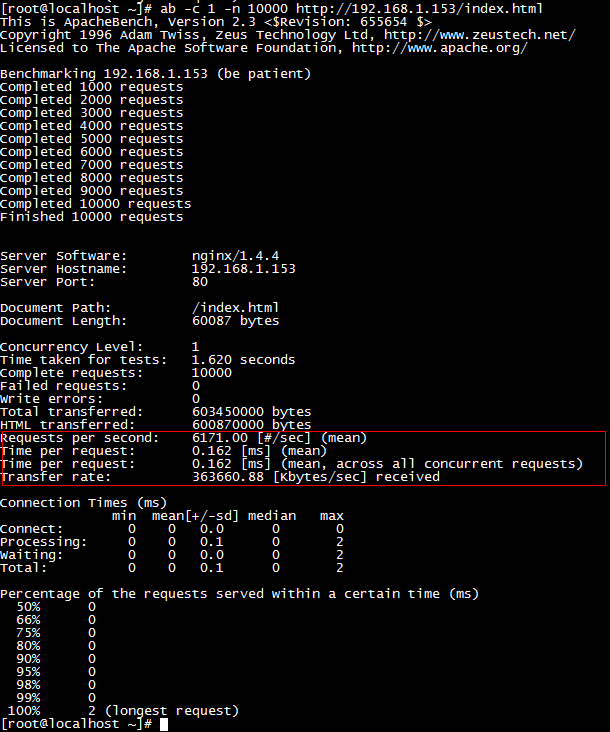目的:nginx处理用户请求的静态页面,tomcat处理用户请求jsp页面,来实现动态分离,nginx处理静态页面效率远高于tomcat,这样一来就能更好的提高并发,处理性能。
准备软件:
下载jdk1.7:http://www.oracle.com/technetwork/java/javase/downloads/jdk7-downloads-1880260.html
下载tomcat8.0:http://tomcat.apache.org/download-80.cgi
下载nginx1.4.4:http://nginx.org/en/download.html
1、JDK配置
|
1
2
3
4
5
6
7
8
9
10
|
[root@localhost ~]
# tar xvfjdk-7u45-linux-x64.tar.gz
[root@localhost ~]
# mv jdk1.7.0_45/ /usr/local/jdk
[root@localhost ~]
# vi /etc/profile
JAVA_HOME=
/usr/local/jdk
PATH=$PATH:$JAVA_HOME
/bin
CLASSPATH=.:$JAVA_HOME
/lib
:$JAVA_HOME
/jre/lib
export
JAVA_HOME PATHCLASSPATH
[root@localhost ~]
# source /etc/profile
[root@localhost ~]
# java -version #显示版本说明成功
java version
"1.7.0_45"
|
2、Tomcat配置
|
1
2
|
[root@localhost ~]
# tar zxvfapache-tomcat-8.0.0-RC5.tar.gz
[root@localhost ~]
# mv apache-tomcat-8.0.0-RC5/usr/local/tomcat
|
#默认tomcat是root身份运行的,这样不安全,我们设置来用普通用户
|
1
2
3
4
5
6
|
[root@localhost ~]
# groupadd tomcat
[root@localhost ~]
# useradd -g tomcat tomcat
[root@localhost ~]
# passwd tomcat
[root@localhost ~]
# chown tomcat.tomcat -R /usr/local/tomcat
[root@localhost ~]
# su - tomcat /usr/local/tomcat/bin/startup.sh
[root@localhost ~]
# echo "su - tomcat /usr/local/tomcat/bin/startup.sh" >> /etc/rc.local #开机启动
|
3、Nginx安装配置
|
1
2
3
4
5
6
7
|
[root@localhost ~]
# groupaddnginx
[root@localhost ~]
# useradd -gnginx -s /sbin/nologin nginx
[root@localhost ~]
# yuminstall –y make zlib-devel openssl-devel pcre-devel
[root@localhost ~]
# tar zxvfnginx-1.4.4.tar.gz
[root@localhost ~]
# cdnginx-1.4.4
[root@localhost nginx-1.4.4]
# ./configure --prefix=/usr/local/nginx --with-http_ssl_module --with-http_gzip_static_module--with-http_stub_status_module
[root@localhost nginx-1.4.4]
# make && make install
|
#主配置文件配置
|
1
2
3
4
5
6
7
8
9
10
11
12
13
14
15
16
17
18
19
20
21
22
23
24
25
26
27
28
29
30
31
32
33
34
35
36
37
38
39
40
41
42
43
44
45
46
47
48
49
50
51
52
53
54
55
56
57
58
59
60
61
62
63
64
65
66
67
68
|
[root@localhost ~]
# vi /usr/local/nginx/conf/nginx.conf
user nginx;
worker_processes 1;
error_log logs
/error
.log;
pid logs
/nginx
.pid;
events {
worker_connections 1024;
}
http {
include mime.types;
default_type application
/octet-stream
;
#日志格式定义
log_format main
'$remote_addr - $remote_user[$time_local] "$request" '
'$status $body_bytes_sent"$http_referer" '
'"$http_user_agent" "$http_x_forwarded_for"'
;
access_log logs
/access
.log main;
sendfile on;
keepalive_timeout 65;
#gzip压缩功能设置
gzip
on;
gzip_min_length 1k;
gzip_buffers 4 16k;
gzip_http_version 1.0;
gzip_comp_level 2;
gzip_types text
/plain
application
/x-javascripttext/css
application
/xml
;
gzip_vary on;
server {
listen 80;
server_name www.
test
.com;
location / {
#jsp网站程序根目录,一般nginx与tomcat在同一个目录
root
/usr/local/tomcat/webapps/ROOT
;
index index.html index.jsp index.html;
}
location ~ .*.jsp$ {
index index.jsp;
proxy_pass http:
//127
.0.0.1:8080;
#来自jsp请求交给tomcat处理
proxy_set_header Host $host;
proxy_set_header X-Real-IP$remote_addr;
proxy_set_header X-Forwarded-For$proxy_add_x_forwarded_for;
proxy_redirect off;
proxy_set_header Host $host;
#后端的Web服务器可以通过X-Forwarded-For获取用户真实IP
proxy_set_header X-Real-IP $remote_addr;
proxy_set_header X-Forwarded-For $proxy_add_x_forwarded_for;
client_max_body_size 10m;
#允许客户端请求的最大单文件字节数
client_body_buffer_size 128k;
#缓冲区代理缓冲用户端请求的最大字节数,
proxy_connect_timeout 90;
#nginx跟后端服务器连接超时时间(代理连接超时)
proxy_read_timeout 90;
#连接成功后,后端服务器响应时间(代理接收超时)
proxy_buffer_size 4k;
#设置代理服务器(nginx)保存用户头信息的缓冲区大小
proxy_buffers 6 32k;
#proxy_buffers缓冲区,网页平均在32k以下的话,这样设置
proxy_busy_buffers_size 64k;
#高负荷下缓冲大小(proxy_buffers*2)
proxy_temp_file_write_size 64k;
#设定缓存文件夹大小,大于这个值,将从upstream服务器传
}
location ~ .*\.(gif|jpg|png|bmp|swf)$
#由nginx处理静态页面
{
expires 30d;
#使用expires缓存模块,缓存到客户端30天
}
location ~ .*\.( jsp|js|css)?$
{
expires 1d;
}
error_page 404
/404
.html;
#错误页面
error_page 500 502 503 504
/50x
.html;
location =
/50x
.html {
root html;
}
}
}
|
#编写nginx启动、停止、重启等SysV管理脚本,方便使用
|
1
2
3
4
5
6
7
8
9
10
11
12
13
14
15
16
17
18
19
20
21
22
23
24
25
26
27
|
[root@localhost ~]
# vi /etc/init.d/nginx
#!/bin/bash
# chkconfig: 345 99 20
# description: Nginx servicecontrol script
PROG=
"/usr/local/nginx/sbin/nginx"
PIDF=
"/usr/local/nginx/logs/nginx.pid"
case
"$1"
in
start)
$PROG
echo
"Nginx servicestart success."
;;
stop)
kill
-s QUIT $(
cat
$PIDF)
echo
"Nginx service stopsuccess."
;;
restart)
$0 stop
$0 start
;;
reload)
kill
-s HUP $(
cat
$PIDF)
echo
"reload Nginx configsuccess."
;;
*)
echo
"Usage: $0{start|stop|restart|reload}"
exit
1
esac
|
|
1
2
3
4
|
[root@localhost ~]
# chmod +x /etc/init.d/nginx
[root@localhost ~]
# service nginx restart
[root@localhost ~]
# chkconfig --add nginx
[root@localhost ~]
# chkconfig nginx on
|
4、性能测试
下面我们使用的ab压力测试工具,模拟发起一次1万的并发请求,使用的index.html页面是百度首页代码
Nginx测试
Tomcat测试
主要参数说明:
Requests per second:平均每秒处理事务数
Time per request:平均事务响应时间
Tranfer rate:平均每秒吞吐量
经上面测试得出:nginx每秒能请求6000次,而tomcat只请求6000次。
nginx每秒吞吐量是3.6M,tomcat每秒吞吐量0.6M
由此看来,nginx是tomcat6倍的处理能力,如果网站程序静态页面多的话,就应该考虑使用Nginx与Tomcat整合来使用。
转http://going.blog.51cto.com/7876557/1343497


